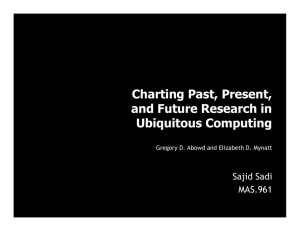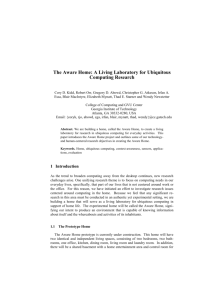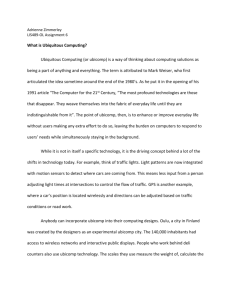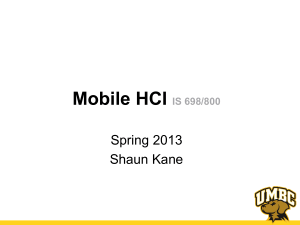,Living Laboratories: at the Georgia Institute of Technology
advertisement
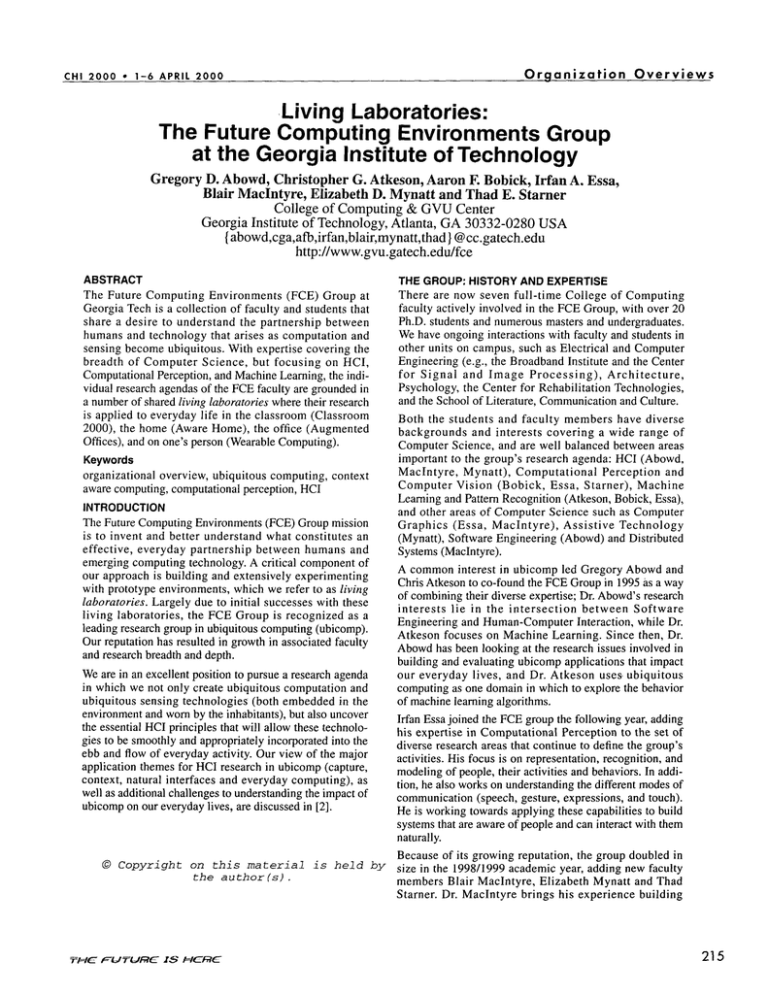
CHI 2000
•
Organization
1-6 APRIL 2000
Overviews
,Living Laboratories:
The Future Computing Environments Group
at the Georgia Institute of Technology
Gregory D. Abowd, Christopher G. Atkeson, Aaron E Bobick, Irfan A. E s s a ,
Blair MacIntyre, Elizabeth D. Mynatt and Thad E. Starner
College of Computing & GVU Center
G e o r g i a Institute o f T e c h n o l o g y , Atlanta, G A 3 0 3 3 2 - 0 2 8 0 U S A
{ a b o w d , c g a , a f b , i r f a n , b l a i r , m y n a t t , thad } @ c c . g a t e c h . e d u
http://www.gvu.gatech.edu/fce
ABSTRACT
THE GROUP: HISTORY AND EXPERTISE
The Future Computing Environments (FCE) Group at
Georgia Tech is a collection of faculty and students that
share a desire to understand the partnership between
humans and technology that arises as computation and
sensing become ubiquitous. With expertise covering the
breadth of Computer Science, but focusing on HCI,
Computational Perception, and Machine Learning, the individual research agendas of the FCE faculty are grounded in
a number of shared living laboratories where their research
is applied to everyday life in the classroom (Classroom
2000), the home (Aware Home), the office (Augmented
Offices), and on one's person (Wearable Computing).
There are now seven full-time College of Computing
faculty actively involved in the FCE Group, with over 20
Ph.D. students and numerous masters and undergraduates.
We have ongoing interactions with faculty and students in
other units on campus, such as Electrical and Computer
Engineering (e.g., the Broadband Institute and the Center
for Signal and I m a g e P r o c e s s i n g ) , A r c h i t e c t u r e ,
Psychology, the Center for Rehabilitation Technologies,
and the School of Literature, Communication and Culture.
Keywords
organizational overview, ubiquitous computing, context
aware computing, computational perception, HCI
INTRODUCTION
The Future Computing Environments (FCE) Group mission
is to invent and better understand what constitutes an
effective, everyday partnership between humans and
emerging computing technology. A critical component of
our approach is building and extensively experimenting
with prototype environments, which we refer to as living
laboratories. Largely due to initial successes with these
living laboratories, the FCE Group is recognized as a
leading research group in ubiquitous computing (ubicomp).
Our reputation has resulted in growth in associated faculty
and research breadth and depth.
We are in an excellent position to pursue a research agenda
in which we not only create ubiquitous computation and
ubiquitous sensing technologies (both embedded in the
environment and worn by the inhabitants), but also uncover
the essential HCI principles that will allow these technologies to be smoothly and appropriately incorporated into the
ebb and flow of everyday activity. Our view of the major
application themes for HCI research in ubicomp (capture,
context, natural interfaces and everyday computing), as
well as additional challenges to understanding the impact of
ubicomp on our everyday lives, are discussed in [2].
© Copyright on this m a t e r i a l
the author(s).
~Hc
Fu~-umc-
zs
~cm~
is h e l d b y
Both the students and faculty members have diverse
backgrounds and interests covering a wide range of
Computer Science, and are well balanced between areas
important to the group's research agenda: HCI (Abowd,
MacIntyre, Mynatt), Computational Perception and
Computer Vision (Bobick, Essa, Starner), Machine
Learning and Pattern Recognition (Atkeson, Bobick, Essa),
and other areas of Computer Science such as Computer
Graphics (Essa, M a c l n t y r e ) , Assistive Technology
(Mynatt), Software Engineering (Abowd) and Distributed
Systems (Maclntyre).
A common interest in ubicomp led Gregory Abowd and
Chris Atkeson to co-found the FCE Group in 1995 as a way
of combining their diverse expertise; Dr. Abowd's research
interests lie in the intersection between Software
Engineering and Human-Computer Interaction, while Dr.
Atkeson focuses on Machine Learning. Since then, Dr.
Abowd has been looking at the research issues involved in
building and evaluating ubicomp applications that impact
our everyday lives, and Dr. Atkeson uses. ubiquitous
computing as one domain in which to explore the behavior
of machine learning algorithms.
Irfan Essa joined the FCE group the following year, adding
his expertise in Computational Perception to the set of
diverse research areas that continue to define the group's
activities. His focus is on representation, recognition, and
modeling of people, their activities and behaviors. In addition, he also works on understanding the different modes of
communication (speech, gesture, expressions, and touch).
He is working towards applying these capabilities to build
systems that are aware of people and can interact with them
naturally.
Because of its growing reputation, the group doubled in
size in the 1998/1999 academic year, adding new faculty
members Blair Maclntyre, Elizabeth Mynatt and Thad
Starner. Dr. Maclntyre brings his experience building
215
Organization
Overviews
distributed augmented reality applications, and research
interests in Distributed Systems and HCI, to the group. His
research focuses on blending an assortment of "new"
interaction paradigms (e.g., augmented reality, tangible
media, ambient displays, wearable computing, and
ubicomp) into cohesive Augmented Environments.
After spending three years exploring the HCI implications
of ubiquitous computing at Xerox PARe, Dr. Mynatt brings
her HCI experience with user-centered design to Georgia
Tech and the FeE group. In her research, she continues to
combine computer science with psychology and sociology
to explore the HCI implications of ubicomp. She is particularly interested in how continuous access to computation
can be integrated into everyday life.
A long-time advocate of wearable computing, Thad Starner
adds a new dimension to the F e E group's vision of
ubicomp through his c o n v i c t i o n that sensing and
computation are often more appropriately located on the
person rather than in the environment. With a strong
foundation in computational perception, his research
focuses on the use of computational agents for everydayuse wearable computer systems.
The newest member of the FeE Group is Aaron Bobick,
who was on the faculty of the MIT Media Lab prior to
joining the Georgia Tech College of Computing in the fall
of 1999. Dr. Bobick brings to the FeE group his considerable experience with the machine perception of movement,
activity and action, and with the integration of HCI and
Computational Perception.
LIVING LABORATORIES
The cornerstone of the FeE Group is a common belief in
the value of creating living laboratories where we can
experience, analyze and improve the very technologies we
are inventing. In these laboratories, we are investigating and
building futuristic computing applications that apply
ubiquitous computing technology to everyday life, such as
in the classroom, the office, and the home. FeE members
have created several living laboratories (Classroom 2000,
the Wearable Computing Project, and Kidsroom [3]) and
are in the process of creating two more (the Aware Home
and the Augmented Office).
Classroom 2000
Classroom 2000 is an attempt to study the impact of
ubicomp on education. The prototype classroom environment seamlessly captures much of the rich interaction that
occurs in a typical university lecture. By capturing the
different streams of activity in the classroom and presenting
an easily accessible interface that integrates those streams
together, we reduce the need for verbatim note-taking,
allowing the student to engage in, and better understand,
the classroom discussion. Our ultimate goal is to
revolutionize the classroom experience through the
evolutionary introduction of a natural and useful capture,
integration and access service. Classroom 2000 has been an
ongoing research effort for over 4 years with over 100
classes taught by more than 24 instructors [1].
216
CHI 2 0 0 0
• 1-6
APRIL 2000
Wearable Computing
As a strong advocate of continuous-access systems, and cofounder of the MIT Wearable Computing Project, Dr.
Starner has worn a custom wearable computer since 1993.
By living with these technologies, Dr. Starner and other
members of the FeE Group are uncovering new issues and
opportunities in areas of augmented memory, augmented
reality, intellectual collectives, and wearable sensing.
Aware Home
We have initiated a research agenda centered around
computing in the home. Because we feel that any significant research in this area must be conducted in an authentic
yet experimental setting, much of this research will take
place in the Broadband Institute Residential Laboratory, a
research house that will be completed early in the year
2000. This house will serve as the living laboratory for
ubiquitous computing in home life. We refer to our
collected efforts as the Aware Home project, signifying our
intent to produce an environment that is capable of knowing
information about itself and the whereabouts and activities
of its inhabitants. We have initiated parallel technologyand human-centered research programs to study the
technologies (such as smart floors) as well as specific
applications (such as support for elderly occupants) [4].
Augmented Offices
We are currently instrumenting a number of office spaces in
and around Georgia Tech to help us study how ubiquitous
computing can be used more effectively in the office
environment. We are interested in exploring how we can
perceive the activities of the inhabitants, and apply that
information to more effectively support office workers who
may be using a diverse set of technologies (such as wall
sized or head-worn displays).
EDUCATION
To push our research themes into the classroom, we teach
graduate and undergraduate courses in Ubiquitous
Computing and run an ongoing research seminar. The
undergraduate class, co-taught by all FeE faculty, gives the
students hands-on experience With ubiquitous computing
technologies. We also integrate ubiquitous computing
issues into our graduate and undergraduate classes on
computational perception, machine learning, embedded
systems, HCI software and evaluation methods for HCI.
REFERENCES
1. Abowd, G. D. Classroom 2000: An Experiment with lhe Instrumentation of a Living Educational Environment. IBM Systems Journal
38(4): 508-530. Special issue on Pervasive computing:, October 1999.
2. Abowd, G. D. and Mynatt, E. D. Future directions for Ubiquitous
Computing. ACM Transactions on Computer-Human Interaction, special issue on HCI research in the 21st century. Provisional acceptance
to appear in 2000.
3. Bobick, A. F., Intille, S. S., Davis, J.W., Baird, E, Pinhanez, C. S.,
Campbell, L. W., Ivanov, Y. A., Schutte, A., and Wilson, A. The KidsRoom: A Perceptually-Based Interactive and Immersive Story Environment. Presence 8(4): 369-393, August 1999
4. Kidd, C. D., Orr, R., Abowd, G. D., Atkeson, C. G., Essa, I. A.,
Maclntyre, B., Mynatt, E. D., Starner, T. E., and Newstetter, W. The
Aware Home: A Living Laboratory for Ubiquitous Computing
Research. Proceedings of CoBuild'99. pages 191-198, October 1999.
c~
2ooo



